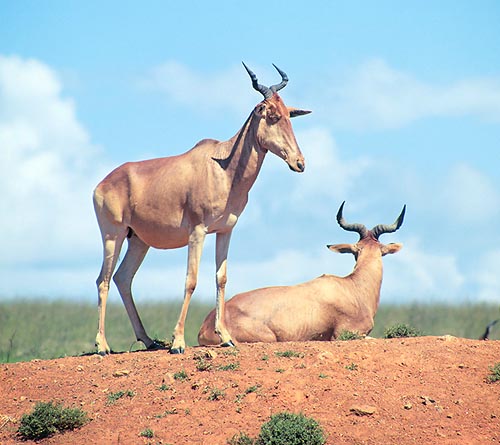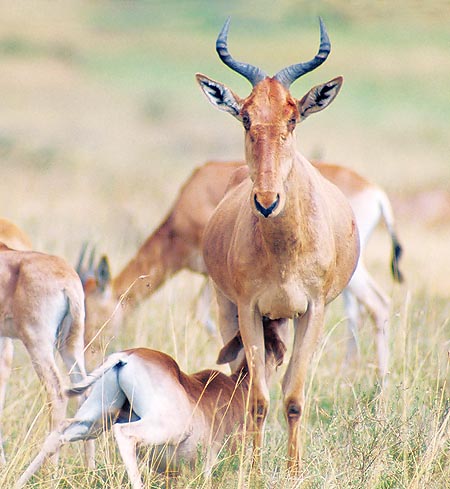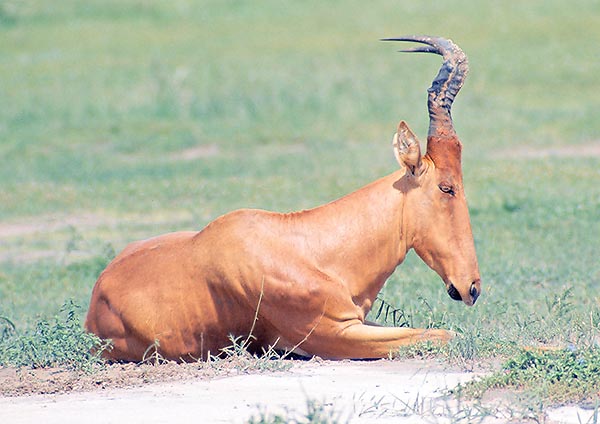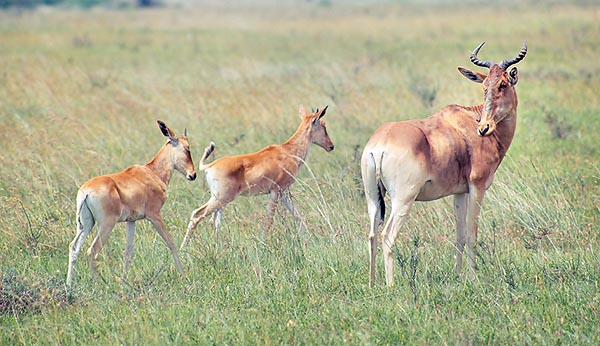Family : Bovidae

Text © DrSc Giuliano Russini – Biologist Zoologist

English translation by Mario Beltramini

Also wounded Alcelaphus buselaphus have a high running resistance © Giuseppe Mazza
Quadruped, placentate mammal belonging to the order of the Artiodactyla, to the family of bovids (Bovidae) and the genus Alcelaphus, the Alcelaphus buselaphus Pallas, 1766, has several subspecies.
It was discovered and studied by the German biologist, zoologist and botanist Peter Simon Pallas in the distant 1766, during one of his expeditions in Africa.
He described it, outlining its classification, into his two fundamental works: “Elenchus Zoophitorum Miscellanea Zoologica Quibus novae imprimis atque obscurae Animalium Species Describuntur”, of 1776 and “Miscellanea Zoologica Quibus novae imprimis atque obscurae Animalium Species Describuntur”, of 1778.
Not much is known about the biology of the species, also because, among all the authocthonous African antelopes and endemic to the savannah, this is the one with minor density of population, shy of character, and not so easy to encounter.
The fact that during the period of colonialism its range extended from North Africa (Morocco, Algeria, Egypt) to eastern and western Africa, and to central southern Africa, is proved by the hunting statements made by the French and English soldiers, who relate about its presence in Algeria, Morocco, Ivory Coast, Congo and other regions, exhibiting as trophies, the typical lyre-shaped horns of this antelope. Other documents of the French army, report the existence in Algeria, Tunisia and Morocco, of an animal they called Alcelaphus bubale (Antilope bubalis), but which, from its description (presence of not much long and lyre-shaped horns, decorated by rings, impressive nimbleness while extricating on the Moroccan plateaus and on step-to and stony grounds), leads to think more to the Alcelaphus buselaphus , rather than to an hypothetical extinct species. Remains of skulls of antelopes, with lyre-shaped horns and morphology similar to those of Alcephalus buselaphus have been found also in the Egyptian tombs of Abadiyeh and in pre-Christian graves in Asia Minor, Palestine and Saudi Arabia, confirming a much wider distribution of the species than the present zoogeographic areas. The first biologists zoologists who discovered such remains in Asia Minor and in North Africa, much before that DrSc Peter Simon Pallas in 1766 did observe this animal in the wild, did not think that it was an antelope, and had imagined the existence of a small sized bovine coming directly from the Bos taurus primigenius.
It has been seen that, during the centuries, the species Alcelaphus buselaphus has subdivided, due to geographical isolation, in 9 subspecies, distributed from central-eastern to central-western Africa, up to South Africa. For instance, a subspecies called Red Hartebeest (Alcelaphus buselaphus caama) is endemic to Cape Town area. From a more detailed zoometric and genetic analysis, the biologists are realizing the the Alcelaphus as genus, belong to great tribe of rather particular and big-sized antelopes, some of them still not much studied, in terms of physiology, nutrition, ethology, ecology and reproductive biology.
Three genera belong to this tribe: Alcelaphus (Alcelaphus buselaphus and its 9 subspecies), Damaliscus (e.g. Damaliscus linatus, Damaliscus pygargus) and Connochaetes with two species: the Blue Wildebeest, Brindled Gnu or Common Wildebeest (Connochaetes taurinus) and the Black Wildebeest or White-tailed Gnu (Connochaetes gnou). This tribe, to which the Alcephalus belong, might not, after recent hypothesis, be part of the subfamily of the Alcelaphinae as thought almost 250 years ago by the biologist P. S. Pallas, but of the Hippotraginae ’s one, which counts, for instance, the Long horns oryx (Oryx gazelle), known as Gemsbok in Afrikaans and in English. But further verifications and studies are necessary before the ITIS, the international organization in charge of the zoological taxonomy accepts this change.

Alcelaphus buselaphus cokii with young © Giuseppe Mazza
Zoogeography
Until the eighteenth century, the Alcelaphus buselaphus was present all over the Saharan Africa continent (Morocco, Algeria, Tunisia, Egypt) and Sub-Saharan to the North, South, West and East, and in Asia Minor (Saudi Arabia, Palestine).
Nowadays, it is found in the wild only in Sub-Saharan Africa, and specifically in the savannahs of central-eastern, central-western and South Africa, in nations such as the Kenya, Uganda, Ethiopia, Somaliland, Soudan, Zimbabwe, Congo and Botswana.
Habitat-Ecology
Its natural biotope is the savannah, where it nourishes grazing several grasses, wild graminaceae, roots, tubers and rhizomes. The grass, which in such prairies can be even 3-4 m tall, grants it a hiding place against the natural predators: Lions (Panthera leo), Leopards (Panthera pardus), Cheetahs (Acinonyx jubatus), but also the ravenous herds of Black-backed Jackals (Canis mesomelas).
Morpho-physiology
Generally, the Alcelaphus buselaphus are animals characterized by a body structure robust and muscular, which gives them high resistance when running and the possibility to reach even the 50 km/h of speed. They have a clumsy way of walking, but, when frightened, they are very fast when running away.
The Boer (for sake of clarity, with the wording Boer or Afrikaner are meant the members of white skinned South African populations, with Calvinist lineage, of Huguenot descent, Dutch, Belgian or German, who spoke the Afrikaans, a dialect born from the fusion of the XII-XIII century Dutch with the English and several African dialects), met, for instance, great difficulties in hunting them, seen their speed and the incredible resistance which allowed the animal to flee also when it was caught by a gunshot.
The Alcelaphus buselaphus have a small skull, prolonging in a long and thins muzzle, ending with a nose covered by bare skin and great nostrils, indicative of a very developed sense of smelling. The females are somewhat bigger than the males. They weigh about 230 kg and reach the 150-155 cm of height at the withers.
They have small frontal eyes, long lance-shaped auricles placed laterally on the skull and under the horns, which are lyre-shaped segmented in rings, with circular section. They are present in both sexes and lay on the bony plate. Hollow and not caduceus, they reach the 50-60 cm in the males, and the 30-35 cm on the females. The curvatures in the terminal trait can be lateral or backwards, especially in the males. These ones have also a small stripe (mane), more or less developed, which starts from the base of the neck and goes up to half of the dorsal trunk. Formed by dark hair and absent in the females, is an evident mark of sexual dimorphism. The mantle, short haired in both sexes, has several brown gradations, darker in the males than the females, tending to beige. The back, the limbs and the head are dark or burnt brown, the back quarters are pale brown. Like the other members of the order of the Artiodactyla, they are unguligrade, but in this species the ungula is very elastic, and this gives a big moving agility even on stony, steep and step-to grounds.
The Alcelaphus buselaphus have a heterodont dentition suitable for a phytophagous alimentation and for the rumination, with relevant adaptation of the gastro-enteric apparatus (see Artiodactyla ). They have an about thirty centimetres long tail, ending with a big tuft of dark hair, which they move for sending away the insects.

Alcelaphus buselaphus jacksoni © Giuseppe Mazza
By comparing the specimens of the 9 subspecies in which the Alcephalus buselaphus is subdivided, the zoologists biologists have isolated peculiar characteristics related to the zoogeographic area of localisation.
We have therefore the Alcelaphus buselaphus lelwel, present mainly in Kenya and Uganda, with reddish brown mantle and V-shaped horns.
In Ethiopia and Somalia we find the Alcelaphus buselaphus swaynei having chocolate brown coloured mantle in the sub adults, before achieving the sexual maturity, that gradually stains of silver, as the hair gets grey hues with the ageing of the animal.
The Alcelaphus buselaphus tora, endemic to northern Ethiopia and Soudan, has a brown mantle and is of small size. The horns are variously bent forward or on the sides already from the base, with greatly wrapped woof on the terminal part, and getting closer to each other points.
The Alcephalus buselaphus caama, once very numerous in South Africa, has been massacred by hunting and by the presence of tamed animals, in the farms of the peasants, who stole them the pasturages transmitting often also pathogen agents such as the Brucellosis abortus or the Neospora canina. Nowadays, the population is drastically reduced and its range is rarefied. They are animals having a chestnut-reddish mantle with white-black dots on the head, limbs and back quarters. Nowadays they are confined in the protected areas of Botswana, Zimbabwe and in South African Republic.
Finally, the Alcephalus buselaphus cokii having completely particular characteristics which are worthy to be described. It lives in central and southern Kenya and in the northern part of Tanzania, with a diminishing population, particularly by the boundaries of its range. Endemic to the grassy prairies and the bush, partly wooded, it goes up till around 2.000 m of altitude above sea level. It is of modest size, with short and diverging horns, and a sandy coloured mantle. But its main characteristic is that, contrarily to the other ruminants, who need great quantities of water, it can live without drinking, like the antelopes of the genus Oryx , being satisfied of the humidity of the ground and of the water contained in the grass eaten. A pure example of ecologic adaptation to the arid zones where it lives.
Ethology-Reproductive Biology
The males of the Alcelaphus buselaphus are territorial, and defend therefore their range from the other dominating males, sending them away butting them, whilst they greedily welcome the females with which they copulate and try to keep them as much as possible.
The females have a bicornuate uterus and syndesmochorial placenta. The pregnancy lasts an average of 8 months, and they deliver always by the beginning of the rainy season, when there is abundance of trophic resources (new grass) for the mother, who needs vegetal proteins for fabricating the milk, and for the young, who assume also solid food, at times, during the lactation. The deliveries are always single. The mothers, as already seen for other herbivores, nourish of the placenta immediately after the delivery, for two basic reasons, the first to recover dietary minerals and the energies lost during the delivery, the second to avoid that a predator, a lion for instance, can perceive its smell and come closer.

Cubs are integrated into the herd when three weeks old © Giuseppe Mazza
We have to remember that the females just before the delivery get away from the herd, going into the bush, in a zone where the grass, tall, even 3-4 m, hides the mother, the future baby and the possible young born the previous year, which is always with the mother, from the predators.
A few minutes after the birth, once licked the new born (thus eliminating any traceable smell), the young is capable to stand on his feet and suckle the milk. After some hours from the birth, it can already walk and run, but does not join the herd for at least two weeks more, remaining, silently, in the hidden area where it was born, entering in contact with the mother only during suckling, therefore the interaction and the parental cares mother-baby are very reduced.
As most of this period is spent by the young in solitude, as the mother after the delivery has joined again the herd, coming there only for the suckling time, some eco-physiologic adaptations have evolutionarily formed, in order to avoid that the unarmed baby can be discovered by a predator. As a matter of fact, the young stays in silence and practically motionless, moving only when the mother comes for suckling, during the whole day and for all the days which separate it from its integration into the herd, where the mother lives. Its odoriferous glands (orbital and under the horns), will remain inactive till when it will not join the herd, in this way its specific odour will not be perceivable by the predators. By each suckling visit, the mother will lick the urine and eat the faeces that the young has produced, for the same reason.
Last physiologic adaptation is represented by (typical for all those species whose offspring shortly after the birth are able to be autonomous in walking) the fact it has the capacity to run away quickly, in case that in spite of all above security systems, it is traced by a predator.
Presently, the population of Alcelaphus buselaphus and its 9 subspecies in which is subdivided, is in constant decrease, reaching so low values that the IUCN has inserted it in the red list of the Threatened Endangered Species.
Cooperating with the CITES and several Zoological Biological Institutes and African, European and American Natural Parks, it is carrying out a series of projects of Taxon Advisory Group (TAG), in charge of the Biology of the Conservation of these animals, in order to avoid their extinction.
Subspecies
Alcelaphus buselaphus buselaphus; Alcelaphus buselaphus caama; Alcelaphus buselaphus cokii; Alcelaphus buselaphus jacksoni; Alcelaphus buselaphus lelwel; Alcelaphus buselaphus lichtensteini; Alcelaphus buselaphus major; Alcelaphus buselaphus swaynei; Alcelaphus buselaphus tora.
→ For general information about ARTIODACTYLA please click here.
